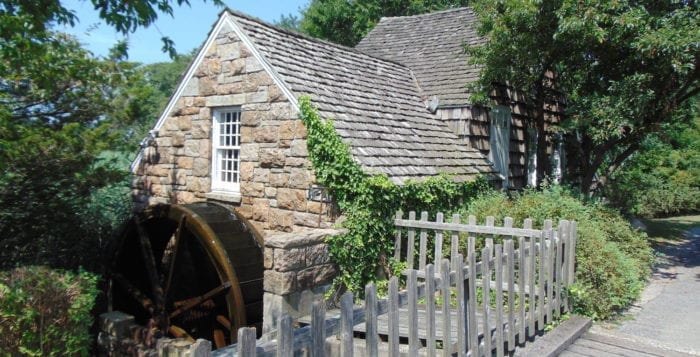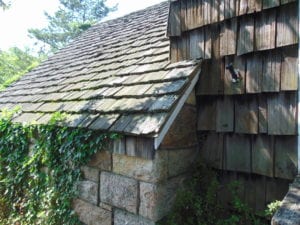Fundraising campaign to begin for Setauket mill restorations

Friends of Frank Melville Memorial Park will be invited to help restore an FMMP staple.
The trustees of the park’s Frank Melville Memorial Foundation are set to send out a letter in September announcing a fundraising campaign asking the community for financial assistance to help restore the mill located on the north side of the park. The restoration, which will include shingling the roof and sides, is estimated to cost more than $60,000, according to Robert Reuter, foundation president.

Reuter said the shingles that cover the roof and sides are the originals and are thicker than the average shingle. They also have irregular cuts on the ends, so rather than lining up in a straight line they have staggered bottoms. This effect will be reproduced during the restoration, according to Reuter. Restorations will also include necessary repairs to the mill’s wheel and trim elements.
“It’s a building in great need of repair,” he said.
Reuter explained that one thing that won’t be repaired is the ridge of the structure that has a noticeable swayback as it was designed to look that way, giving it an old mill feel.
Richard Haviland Smythe designed the simulated mill in the mid-1930s to represent a series of grist mills that once existed along waterways in Setauket, including one that was constructed in 1665 and located in the park, Reuter said. Smythe was the go-to architect for philanthropist Ward Melville and designed many local buildings, including structures in Old Field Farm and stores in the Stony Brook Village Center.
“It was meant to be a place marker and a reference to the mills of the past,” he said.
Reuter added the mill is sometimes called a landmark folly, and it was included in the original design of the park, which is loosely based on English garden principles.
“It’s a very important building in the park, and maybe the most photographed element in the park,” Reuter said. “I would say it’s one of those iconic images that everyone takes a photo of.”
He believes it also serves a purpose beyond aesthetics, because even though it’s not an operating mill, it has a working wheel and the building is used for the Frank Melville Memorial Foundation’s office. The mill is also used for tours and is a stop during the annual Culper Spy Day held in September.
“It allows us to tell the story of that part of our history,” Reuter said. “How the mills moved as the ponds filled in and the mills had to move down, and this represented the last position for a mill that [was in Setauket].”
Three Village Historical Society historian Beverly Tyler said the mill is a stop on the Founders Day tour that the society conducts every spring for fourth graders. It’s also featured on the Woodhull tour that the TVHS offers and he leads.
Tyler said the mill serves as a learning tool to teach participants about millers and craftsmen who worked in the area throughout the centuries, especially during the Colonial period. He explained millers did more than grind grains — often acting as a storekeeper and banker in town because they had the resources to loan money.
“Without the mill, we wouldn’t have the ability to teach it as easily and dramatically as we can by having the mill there and explaining how the mill pond works and why there is a mill pond,” Tyler said, adding the pond exists because water was backed up by a dam to enable milling.
Reuter said the board hopes to begin the restoration project this year, and two FMMF trustees already have made a combined pledge of up to $10,000 to match donations for the restoration. Those who donate $50 or more will receive the 2020 Four Harbors Audubon Society Calendar, which features selected photographs from the recent A Valentine to Whitman’s Paumanok photography exhibition held at the Bates House.






